This video was played at the students’ presentation to their community on May 12, 2017 and is a 20 minute overview of the Karuna Project.
Filmed and edited by Devin Kumar.
This video was played at the students’ presentation to their community on May 12, 2017 and is a 20 minute overview of the Karuna Project.
Filmed and edited by Devin Kumar.
Here are some post-trip reflections from the seniors of Mount Madonna School on their experience of the Karuna Project

Unlike many others, India did not “change” my life. Instead, and in my opinion more importantly, India broadened my perspective of the world we live in. India is a culture with a rich history, tradition, and people. The people of India are some of the kindest, most genuine people I have had the pleasure to meet. They shower you in love with the first hello, and treat you as if you are family even as you get to know each other.
As a story teller, I have learned that you must first experience a story before telling it. And, as a writer, I often feel this itch for stories of exploration and adventure. However, I have had trouble writing about a hero who leaves his home and jumps into the unknown to find out what’s out there. After India, I finally feel my thoughts flow through my pencil with these stories. And, I am very grateful to be able to finally call myself an adventurer.

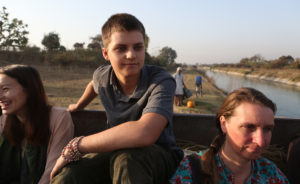
Upon stepping out of the airport in New Delhi, I immediately noticed how different everything was. Cars and motorbikes zip by missing you by mere inches. It’s scary, and new at first, but it only takes a few minutes to adjust. On the first day, our first stop was Jama Masjid, one of the largest Mosques in India, placed in the heart of Old Delhi. It’s an extravagant piece of architecture, and beautiful too. Being there, and at the Golden Temple in Amritsar made me realize how much cultural diversity there is in India. Hindus, Sikhs, Muslims, Christians, Buddhists and many other faiths are able to live together harmoniously. Everyone I met seemed to not care about race or religion. This was one of the things about India that truly surprised me. Another thing that I noticed was how friendly everyone is. Many people came up to me to ask me where I was from and what I was doing in India. They weren’t asking to be rude, they were simply curious about us. From the very beginning, I felt welcomed in India. On the first day, riding around Old Delhi on the rickshaws, I noticed how different a culture and country India is from the United States. However, even though India is like nothing I had ever experienced, I didn’t feel out of place. I still felt at home.
Thanks to everyone who followed along our learning journey to India! Check back here over the next couple weeks for some final reflection from the students, photos, and a full video of the entire trip.
A big thank you to everyone who made this possible especially our on-the-ground support in India. The Karuna Project was a great experience. The Mount Madonna students will give a presentation on their journey at Mount Madonna School on Friday May 12th at 9am in the Assembly Room at Mount Madonna School. Please join us if you are able!
By Mount Madonna School alumni Emma Petersen and Courtney Bess

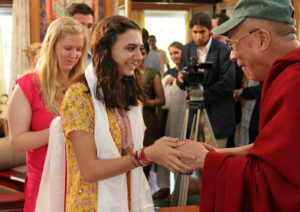
Flashback to April 2011, I had never been out of the United States and I was preparing for a trip I knew could change my life but still was not sure how I was going to absorb the experience. I didn’t dive right in. I stayed to myself and my friends for the first few days of the trip. I stuck to what I knew. But then, when we started going to schools, hearing about how students in this country learned, and were given the chance to speak with them about it, I started making friends and connections I never thought I could. I was making friendships with people that grew up completely differently than I had, in school and home life, yet we still had a lot in common.
It took me until my second year of college to fully understand the opportunity I was given by Sadanand and Mount Madonna School. I started taking classes that I was able to relate my trip to, things I had heard and the things that had changed me. I remember specifically talking to His Holiness, the Dalai Lama, I asked him, “What to you is happiness?” I remember, I was a sophomore in college at the time, I was dealing with some personal anguish about what major I wanted, and if I wanted to change from a psychology to a teaching major. I was struggling because I was afraid to disappoint my parents. When I called them to tell them what I was thinking they were overjoyed, and my mother told me she knew that was the path I was always meant to go down, and that she just wanted me to do what made me happy. I thought back to the Dalai Lama interview and what he said, “You know when you pet a dog and he wags his tail, that is happiness.” How can someone so wise give us such a simple, modest answer, I had thought at the time when he answered it, but hearing my mom say those words to me, it was that simple. Why trouble myself doing something I did not like? I should be wagging my tail because I am being fed with the knowledge of how to grow young minds.
Fast forward to April 2017, I am now preparing for the journey home. I traveled back to India with the Senior Class of 2017 and a fellow alumni, Courtney Bess. I had always dreamed of coming back, older and able to understand the experience more. I told myself the day I got on that bus leaving the Sri Ram Ashram in 2011, while Kiran held my hand all the way to the gate, I would be coming back again. I never could have imagined it would be like this, a chaperone to a class I greatly respected.
This trip has deepened my senses for my emotion, everything from the interviews to the connections I have made with the children we have met along the way. I found myself in the interviews truly absorbing what the people were saying, not just thinking I need to take notes in case I am asked to write a blog post, but truly understanding and getting goosebumps because I was able to relate to them. Rinchen Khando spoke about compassion and how it overflows with students that are excited to learn. I feel that every day with my students. They are so eager to learn new things and are appreciative when I teach them something new. It is refreshing. Dr. Metre spoke about allowing differences in the villages and how their goal is not to make all the villages the same, but to keep their traditions and help support the women be able to stand on their own financially. I was able to relate to that because I teach a class that is predominantly Hispanic, and even though I am teaching them English, I strongly encourage their families to continue speaking Spanish to them. It is important for the children to keep their traditions at home and be able to speak freely about them at school and know they are supported. Both Rinchen Khando and Dr. Metre spoke to me and made me feel more proud than I normally do about the work I am doing.
Lastly, driving into the gates of the ashram once again, I immediately began crying, it felt as though I was home. It had been six years since I had last been there. I didn’t imagine that the children I had bonded with before would remember me, specifically Kiran, 9 at the time and now 15, and Jhanvi, 6 months at the time and now 5. As we unloaded the buses, Kiran greeted me, she shook my hand and introduced herself to me, I told her we had met before 6 years ago. She scurried off to her room and when she reappeared she had the picture Devin captured of us saying goodbye on that day in 2011. She remembered me! Jhanvi on the other hand, I knew wouldn’t remember me, but it was like she was drawn to me. We continued our relationship and it was as if I never left. As we said our goodbyes and I loaded back into the bus, I reflected back on how this trip is not only a continuation from my last trip, but has increased my appreciation for this bright, colorful, energetic, inviting country. India has given me a second home, I knew I was meant to come back and visit, and I know now that it is forever a place I will return. It has given me memories that I will never forget and ones I wish to expand upon in the near future. Namaste.
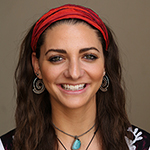
Khushi…the Hindi word for happiness. While I expected this learning journey to be influential and expose me to unique opportunities, I did not anticipate that it would result in a personal redefinition of the word happiness.
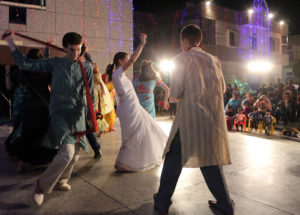
The night I watched the series of performances put on by the kids at the Sri Ram Ashram, I felt tears welling in my eyes. It wasn’t the typical reaction one might expect from someone watching an upbeat dance carried out by adorable, smiling faces. My emotions were stirred by what was physically happening on stage, but they were intensified even more by the ease with which the kids seemed to exude authentic happiness. In this pivotal moment, I felt a mixture of envy, admiration, and wonderment.
This expression of genuine happiness proved to be a common thread amongst the many individuals and groups of people with whom I interacted during my time in India. Since finding myself consistently surrounded by such sincere contentment, I have been making a conscious effort to examine the similarities across these groups in an attempt to discern a formula for happiness that I can carry with me for the rest of my life.
At Pardada Pardadi Educational Society, the students demonstrated a passion and appreciation for education that was absolutely inspiring. These students all come from homes with an income that places them below the poverty line. They have reasonable hope that a quality education will lead to a better life for them and their families. I could see that this opportunity to receive an education brought them all such joy, as they eagerly told us about their studies and showed us around their school with energetic grins and radiant pride.
The Sri Ram Ashram is a place where children who are not fortunate enough to have come from loving homes are given the chance to be a part of a safe and loving family. At the ashram, children may not have a profusion of material items, but they are allowed an opportunity for a better life. They are showered with more love and support than can be put into words. In spite of the adverse circumstances in which these children were born, they are now thriving as part of one big devoted family.
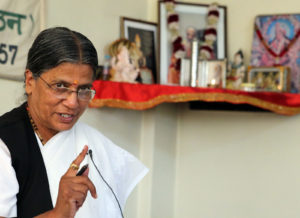
When we spoke to Dr. Metre at CORD (Chinmaya Organisation for Rural Development) another source of happiness was brought to my attention. At CORD, women are given the tools and education necessary to allow them to minimize their over-dependency on their husbands. This functions to build the self-esteem and confidence in women in hundreds of surrounding villages. Those who have been helped in this way by CORD programs are now living freer and happier lives than they had been previously.
Genuine happiness is something that has always been tough for me to find, despite my relatively privileged upbringing. It was something that was palpable amongst the inspiring people I have engaged with over the past two weeks here in India—people who are not nearly as fortunate in regards to their life circumstances. In what I witnessed at Pardada Pardadi, Sri Ram Ashram, and CORD, I recognized that material wealth is not the sole measurement of one’s happiness. I realized that some of the key ingredients to a life of happiness are education, love, support, and opportunity.
Before I make it sound like my life lacks education, love, support, and opportunity, I want to clearly state that I have all of those things. The difference is that I have yet to understand how to use these tools to build myself a life of happiness. Dr. Metre shared with us a story that referenced a “mind bath.” Essentially, a mind bath is the creation of mental silence to ignite mindfulness and obtain clarity in one’s thinking. Using this idea, I have decided that I am in need of a mind bath. I need to combine the resources with which I’ve been blessed with my redefinition of happiness. If I do this, I can construct a life filled with the kind of joy I saw in the eyes, smiles, and souls of the kids at Sri Ram Ashram as they performed for us that night.
Photos by Shmuel Thaler
Interview with Dr. Kshama Metre of the Chinmaya Organisation for Rural Development (CORD)
View the video of the interview here.

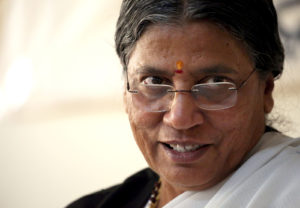
Sometimes simplicity can be the most enlightening thing a person can offer. One might expect pieces of advice that are the most detailed, lengthy, and well-explained to be the greatest in terms of their impact and effectiveness, but this is not always the case. Dr. Kshama Metre made this perfectly clear. She has the mind of an intellectual and one might assume that it is constantly whirling with strategies for achieving equality, and ethical solutions for problems facing Indian women. While this may be the case, the way she externally conveys her thoughts is almost the exact opposite. Dr. Metre communicates many philosophical ideas in a stunningly simple and understandable manner. For example, when asked about the “journey within” and its importance she relayed a story about a little girl at an ashram who told her about “mind baths,” little five-minute periods in one’s day that you use to check in with yourself and see how you’re doing. She didn’t call them “introspective expeditions,” or “existential explorations,” just “mind baths.” Nothing more, nothing less. Normally when we ask for advice from the inspiring people we interview, we often get a wholesomely stirring response that’s about a minute long. When we asked Dr. Kshama Metre for advice she shared only two words but they spoke volumes about her profound understanding of the human spirit and its needs. Those two words were, “Know yourself.” Simple.

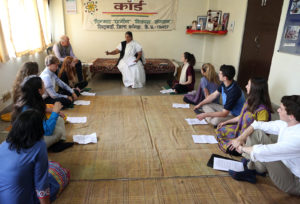
The first question was asked, and Dr. Kshama Metre took a long time to think. Her mind swirled with ideas, and what came out was a concise, well-worded answer. Each question was answered with a humble and short reply after only a second of gathering her thoughts. I was a little surprised at how simple and confident she was in her responses, considering the complex ideas she was explaining. When asked what true equality meant to her, she answered simply, “Equality is not being greedy.” She acknowledged the dimensions of the term, but emphasized the three-word response. Another three-word response was about love; “love is expansive.” Her ability to describe these words, which have countless complexities, with such simplicity made her answers genuine and sincere. I haven’t met many people with the ability to answer our questions so thoughtfully yet concisely. Because of this, I felt drawn into everything she was saying. Dr. Metre has achieved extraordinary things in her life, and her humble demeanor was inspiring. To finish the interview, she gave us some advice for our lives going forward, another short answer that I know I will carry with me; “Know yourself. Once you know yourself, you will know everyone else.” In most interviews, the answer to the advice questions draws a long answer, but this was her entire response. It was simple, confident, and humble, perfectly reflecting her personality.


After our inspiring interview with Dr. Metre, we split into two groups and went into the villages to see some of the self-help groups we learned about at CORD (Chinmaya Organisation for Rural Development). Once we arrived in the village, we walked toward a group of about twenty women. They arranged a line of chairs for us and asked each of us to introduce ourselves, which we gladly did. We learned a lot about how the group functions, and how they help the women involved. Each woman pays a set amount of rupees to the group monthly. If someone gets sick or needs money for another reason, they can take a loan out from the group. This is helpful as it allows the women to have some level of economic independence from their husbands.
We were all surprised when they wanted us to sing them something. With half of our class, including our ukulele player, in another village, we weren’t sure how it was going to go. We ended up surprising ourselves by sounding pretty good. In response to our song, the group sang their own. Some of the women stood up and started dancing to the song as we clapped along. They took Izzy, Savannah and me, by the hand, put us in a circle and asked us to dance. We tried our best to do the dance moves they had been doing moments earlier, but their laughs and chuckles told us we weren’t quite doing them right.
Although I won’t remember that trip to the village for our stellar dance moves, I’m never going to forget how much fun we had and how connected I felt to the women.
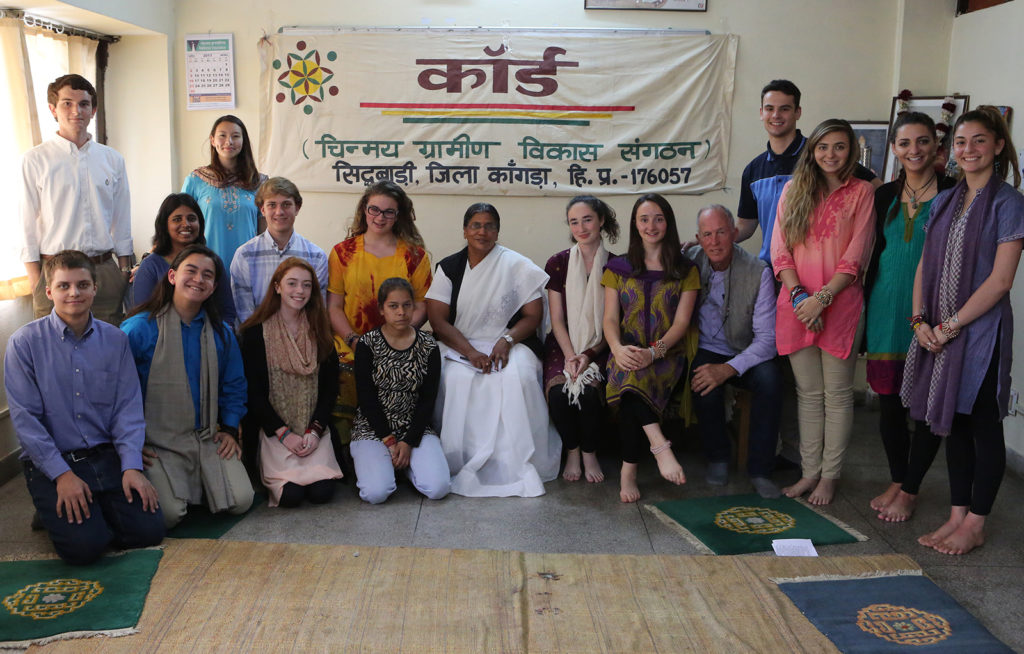
Mount Madonna School students visit the Golden Temple in Amritsar, India as part of their Karuna Project.

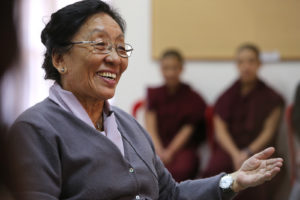
Today was my first day feeling fully recovered after a brief spell of dehydration. I am so happy that I was back for today because it was probably one of the best days of my life. I cannot imagine a life where I do not return to McLeod Ganj. I love waking up to look out at the incredibly beautiful Himalayan Mountains dotted with colorful rooftops. It’s also nice to be surrounded by the Tibetan culture which more familiar to me. It’s comforting to be surrounded by ringing bells, chanting, and flowing vibrant red and yellow robes.
We started off our day with our first interview of the trip, Rinchen Khando. Rinchen Khando is the leader and founder of the Tibetan Nuns Project. As soon as she began talking she became my role model. She spoke beautifully about the value of educating women just like men. She said that in the beginning there was talk of offering the nuns an easier scholarly path, littered with concessions like a lower passing grade or an easier textbook, but that we should take no concessions, because it is important for the welfare of society that women and men are educated equally. She said that when women and men are taught the same it will be easier to stop seeing the distinction between the two, and simply view everyone as human. I thought this was powerful, especially coming from a culture where traditionally nuns could not receive a Ngagrampa degree, only monks could.
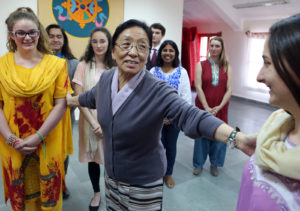
What struck me personally was when she answered the question that I asked, she answered and looked at me with raw attention and care, as though I was one of her family members. I asked her about the importance of art in her work, which is relevant to me because I intend to pursue art and animation in the future. She said that art is so influential, and that with animation, I could really distribute my message and make an impact. She talked about its relationship to journalism, and how there are artists and journalists who can be told to create information for the sake of money, bribery, or other reasons. But she said that if I do not do that, if I stick to my own wisdom and my own truth, then what I create will be powerful. She made me realize that by going into art, I am not just going into an uncertain future, I am going into a life where I create art that is a force to be reckoned with. At the end of the interview, after we took a group picture, she turned to all of us and said that when she looks at us, it is as though she is looking at a group of Tibetan children. In that moment I honestly wanted to walk out with her, ask her to mentor me, and follow her for a few years. Meeting her was truly inspirational and I am eternally grateful for the experience.
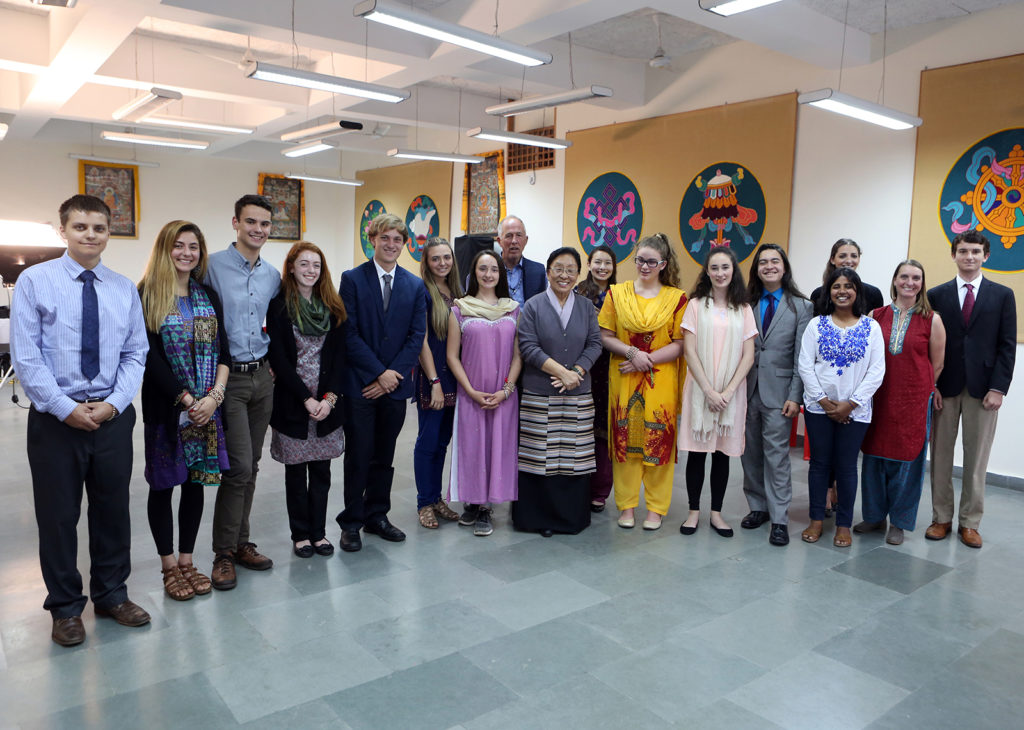

After waking up to a big storm and no power in the hotel, we struggled to get ready for the two interviews we had lined up today. With no internet and no printer, our interview questions for Samdhong Rinpoche were polished and printed while we ate lunch at a nearby restaurant. We rushed through our meal and in no time, he was walking around the room shaking everyone’s hand.
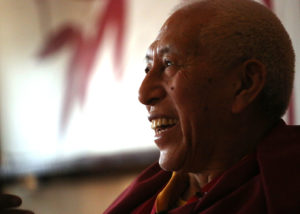
Samdhong Rinpoche thought long about our questions before giving us his detailed, eloquent answers, pausing every once in a while, to ponder or gather his thoughts. Although almost everything he said had extreme depth and struck me in some way, I was especially interested when he spoke to us about the concept of non-violence. He told us that non-violence as a strategy is not true non-violence. This is very similar to John Lewis’ belief that you can’t turn non-violence on and off, it is a way of life. I began to think more deeply about this and was reminded of the Dalai Lama’s book, Ethics for the New Millennium. In his book, the Dalai Lama speaks of suffering, and specifically how sharing in another’s suffering can in turn, alleviate your own. However, sharing in another’s suffering for the sole purpose of alleviating your own is not truly sharing in another’s suffering, therefore, your suffering is not alleviated. This is similar to what Samdhong Rinpoche was telling us because by using non-violence as a strategy, you are using it for the sole purpose of getting something you want, rather than for the purpose of living by the non-violent belief.
I had never thought about the difference between using non-violence as a strategy and living by non-violence but now the difference seems extremely clear. I thoroughly enjoyed our interview with Samdhong Rinpoche because it caused me to think deeply about Buddhist beliefs such as non-violence which I had only thought about on a surface level before.
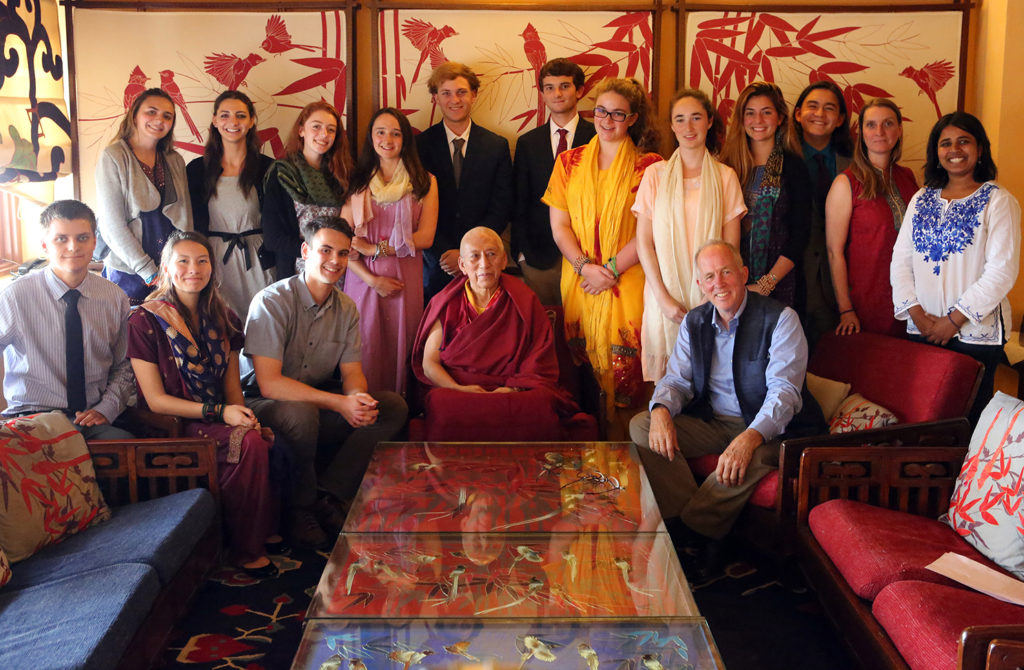

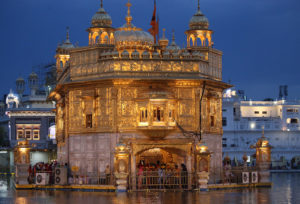
As I approached the Golden Temple I could feel the reverence of those who strolled past me. Everyone moved with a purpose that showed how excited they were to be in this holy place. I walked over the steps that led to the grand courtyard. In the center of the courtyard sits a gigantic pool that contains a temple covered in gold. Hundreds of people stood on the bridge that reached across the rippling water. They waited patiently for their turn to walk inside and pray in the shimmering and ornate building. Slowly, as we circumnavigated the massive pool, the now rising sun cast its orange glow above the wall of the compound. We took a moment to sit and listen to the soothing prayers that were being sung. Their beautiful melody gave life to the temple.
I sat, feeling the presence of the thousands of people who filled the courtyard. I gazed across the water, taking in the stillness of the place despite the movement of people. I stood to pose with our group for a few more photos then felt myself float out of the peacefulness that I felt moments before. We crossed the threshold of the compound back out into the open world. I felt the busyness hit me like a wall. It’s incredible that in just a matter of moments you can be transported between two completely different worlds. I’ve learned that in India three steps can be the difference between grace and chaos.

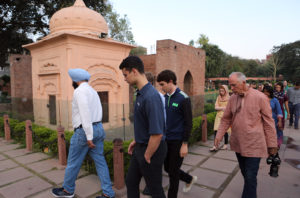
I reached my arms and saw that there was only a few inches keeping my fingers from sliding against the orange cement walls. These walls were the only way to enter and exit the courtyard of Jallianwalla Bagh, the historical site where a peaceful protest inspired by Gandhi ended in a massacre of hundreds of people. As I entered the garden, I tried to swallow away the pain that harvested in my chest. I pictured crowds of nonviolent protesters, cooped up like livestock, running from British bullets, and my ribs tightened around my heart beat. The bullet holes still remain in the weathered brick walls that stand in the garden. I could hear the 1,650 rounds being shot into the crowd, the hot cartridges dropping to the ground as the sounds of bodies followed; my ears burned. I began weaving myself through a crowd to the well that people hurled their bodies down in order to not have their lives be taken by the violent bullets, that brutally interrupted a non-violent protest. I watched flower petals settled to the bottom of the well as silence placed itself onto the lips of the observers. Yet, I could still hear the beating of those hearts around me. Hearts that felt the same pain I did; hearts that wanted to reconstruct the past.
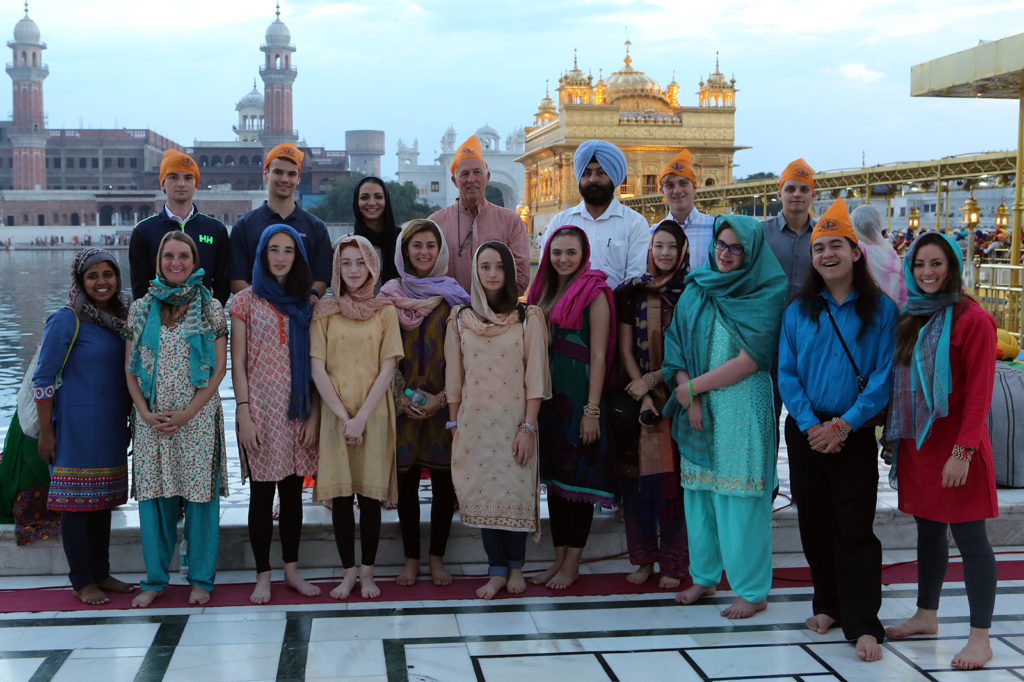


Due to the graciousness of Rashmi, we got to experience “swimming” at the ashram. The pool was only going to be filled a little more than knee height, and to be honest I wasn’t expecting much. After all, knee height doesn’t offer much for my “thick,” 6’2” body. Yet, considering the heat, the call of the cool water was just too enticing.
As soon as we were released from dance practice Devyn, Isaac, and I sprinted over as a cohesive unit ready to dive into the shin deep water. As soon as we arrived, we realized it was filled to the brim with all the kids. We hesitated but the lure of cool water was too strong. Our entrance seemed to be the spark of the GREAT SPLASH WAR and as we engaged in battle we tried to keep the water out of our mouths. Our efforts were made even more futile when Naresh, a 16-year-old ashram brother, entered the war by immediately tackling me into the water. Devyn, Isaac, and I almost instantly had our backs against the wall as the whole pool turned on us as we desperately defended our position. After successfully defending ourselves from the first round of attacks, I found myself betrayed by my former comrades. I was getting bombarded from every direction. My attempt at the fetal position against the wall offered little refuge.
Over all, this was a great way to end my day. In addition to having a blast, the pool party served as an opportunity to interact with the younger kids I had not yet gotten to know. Unique moments like this, at Sri Ram Ashram, allow us to deepen our relationships and encourage cross-cultural interactions. This is one of the many attributes of the ashram that makes it the special place that it is.
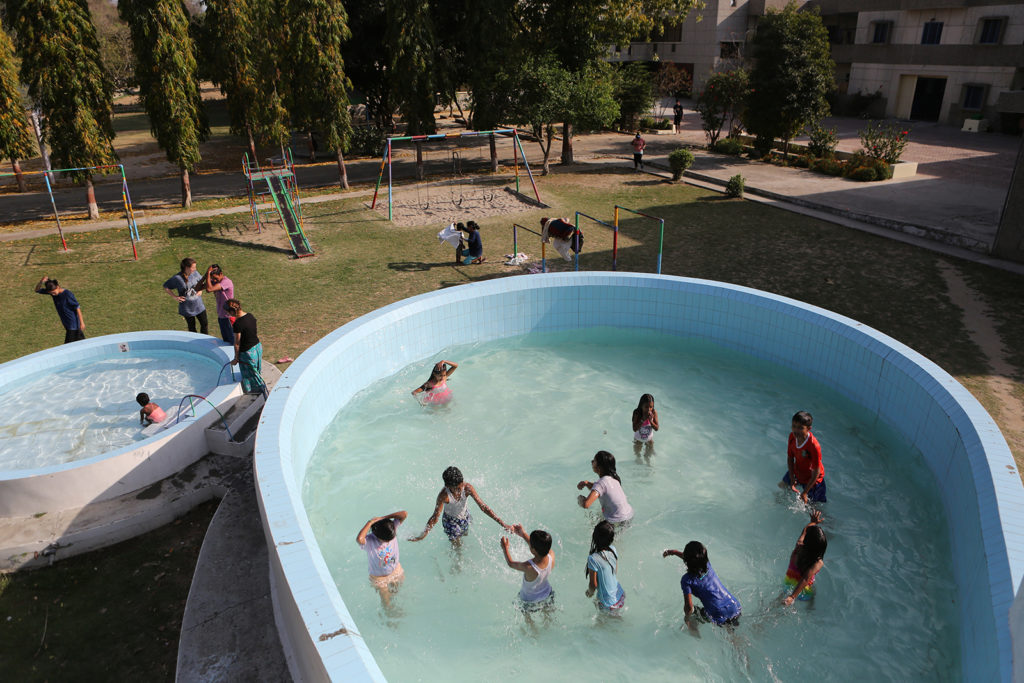
You must be logged in to post a comment.